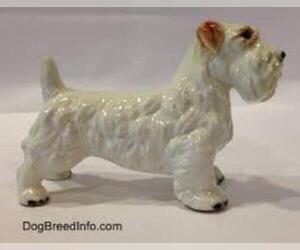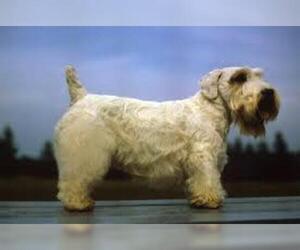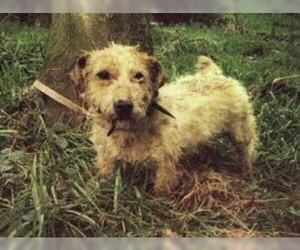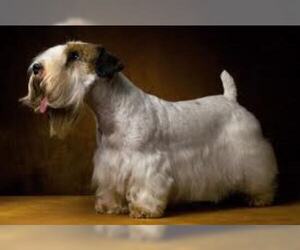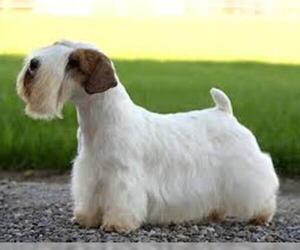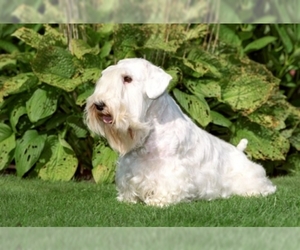
All about Sealyham Terrier dog breed
A.K.A. :Sealy, Sealys, Rollers, Sealyham, The Sealy
Size
Grooming requirements
Exercise requirements
Good with other dogs
Watchdog ability
Energetic
Training requirements
Playful
Affectionate
Good with other pets
Good with children
Good with strangers
Winter
Summer
Healthiness
Protective
Life Span
| Pure Breeds | Member |
| Breeds A - Z | S |
| Breeds by Group | Terrier |
| Breeds by Trait | Hypoallergenic Low Shedding |
| Overview: | The Sealyham Terrier is a charming and spirited breed originating from Wales in the mid-19th century, specifically bred for hunting badgers and otters. Physically, they are sturdy, low-slung dogs with a distinctive long, flowing white coat and a strong, square head often adorned with a "beard and mustache." Their temperament is generally outgoing and playful, exhibiting a characteristic Terrier feistiness combined with a devoted affection for their families. While they possess an independent streak, they are intelligent and respond well to consistent training. Sealyhams can adapt to both family life and apartment living, provided they receive adequate exercise and mental stimulation, as their moderate energy levels require regular walks and playtime. Owners should be mindful of potential health concerns such as eye conditions (like Progressive Retinal Atrophy) and allergies, making regular veterinary check-ups essential for this delightful companion. |
F.A.Q.
All You Need to Know About the Sealyham Terrier BreedThe Sealyham Terrier is a charming, small-to-medium-sized dog originating from Wales, bred for badger and fox hunting. These plucky canines are renowned for their courageous yet affectionate temperament, making them wonderful companions. Physically, they boast a distinctive white, wiry coat and a sturdy, low-slung build, typically weighing between 20-24 pounds. Sealyhams are excellent family dogs, loving and playful with children, and generally get along well with other pets if socialized early. Their moderate size means they can adapt to apartment living as long as their daily exercise needs are met with walks and playtime. Grooming involves regular brushing and occasional stripping to maintain their iconic coat. Like many breeds, they can be prone to certain health issues, including eye conditions and deafness, so choosing a reputable breeder is crucial. Overall, the Sealyham Terrier is an intelligent, devoted, and delightful breed for active households seeking a loyal companion.
Sealyham Terrier Weight: A healthy adult Sealyham Terrier typically weighs between 20-24 pounds. While there isn't a significant difference, males may sometimes be at the higher end of this range, and females at the lower. This is the average size for a well-built, healthy Sealyham Terrier, an important factor for potential adopters considering the breed's size and build.
Wondering about the Sealyham Terrier height? These charming little terriers have a fairly consistent average size, making them a great fit for various living situations.
The average height of a Sealyham Terrier is typically between 10.5 to 12.5 inches (approximately 27 to 32 cm) when measured at the shoulder. This range represents the typical adult height for a healthy, well-developed Sealyham.While there isn't a significant height difference based on gender, you might find that males tend to be at the higher end of this range, while females might be slightly smaller. However, individual genetics play a larger role, and some individuals may fall slightly outside these measurements. When considering how tall is a Sealyham Terrier, remember that a compact, well-proportioned build is more important than hitting an exact height. This average size contributes to their sturdy yet agile nature.The Sealyham Terrier colors are primarily white. The American Kennel Club (AKC) officially recognizes all white or white with badger, badger pied, blue, lemon, or brown markings. These markings are typically found on the head and ears. While rare coat types and exotic Sealyham Terrier variations like solid blue, lilac, merle, or chocolate are not accepted by major kennel clubs and are not typical for the breed, any dog advertised with these colors would likely be a mixed breed or have non-standard genetics, and prospective buyers should exercise caution. Focus on AKC recognized Sealyham Terrier colors for purebred Sealyhams.
The Sealyham Terrier personality is a delightful blend of playful spirit and unwavering loyalty. These charming dogs are known for their affectionate and devoted nature, forming strong bonds with their families. While generally friendly and outgoing with their loved ones, they can be a bit reserved with strangers, showcasing their protective instincts. Their temperament of Sealyham Terrier is quite adaptable; they can thrive in various living situations, making them well-suited for apartment living as long as they receive adequate exercise and mental stimulation.With children, Sealyhams are typically patient and good-natured, enjoying playtime and companionship, though supervision is always recommended with very young children. Their intelligent and curious minds make them quick learners, but they can also possess a stubborn streak, typical of many terriers. When it comes to other pets, early socialization is key. While they can coexist peacefully with other dogs, their strong prey drive, a hallmark of the terrier group, means they may view smaller furry animals as chase objects. Overall, the Sealyham is a courageous, entertaining, and loving companion for those seeking a spirited yet devoted canine friend.
Sealyham Terrier Temperament & Personality TraitsThe Sealyham Terrier is a charming, intelligent, and spirited companion dog known for its lovable and confident personality. They are loyal and devoted to their families, often forming strong bonds. Generally, Sealyhams are friendly and outgoing with their human companions, but their natural terrier instincts mean they can be alert and reserved with strangers initially.This breed is highly adaptable, and while they enjoy having a yard, their moderate size and exercise needs make them well-suited for apartment living provided they receive daily walks and mental stimulation. They are energetic indoors and enjoy being part of family activities.When it comes to children, Sealyhams can be wonderful playmates for older, respectful children who understand how to interact with a dog. Due to their sometimes feisty nature, supervision is always recommended with very young children. Their history as a hunting dog means they possess a strong prey drive, which can make them challenging with other small pets like cats or rodents unless they are raised together from a young age and properly socialized. They can often coexist happily with other dogs, especially if introduced thoughtfully.While intelligent and eager to please, Sealyhams do have a classic terrier stubborn streak. They respond best to positive reinforcement and consistent training from a young age. They are not overly sensitive but thrive on clear communication and a loving, firm hand. Expect a lively, engaging, and affectionate companion that will bring much joy and entertainment to your home.
Sealyham Terrier Care: Daily Maintenance & Health TipsSealyham Terrier care is generally straightforward, making them a good choice for various households. Their grooming needs are moderate; regular brushing (2-3 times weekly) helps maintain their distinctive double coat and prevent matting. Stripping or professional grooming every 2-3 months is essential to keep their coat healthy and tidy.Despite their terrier energy, Sealyhams are a low-energy dog breed indoors. They require moderate daily exercise, typically 30-60 minutes of walks or playtime, to stay physically and mentally stimulated. How to care for a Sealyham Terrier's diet involves providing high-quality dog food appropriate for their age and activity level. Due to their tendency to gain weight, portion control and weight management are crucial to prevent obesity.Unlike some brachycephalic breeds, Sealyhams don't have pronounced wrinkles, but routine ear cleaning (weekly) is necessary to prevent infections. While not strictly brachycephalic, they can be sensitive to extreme heat due to their coat and shorter muzzle, so climate sensitivity requires awareness during hot weather.Common health tips for Sealyham Terrier owners include vigilance for skin issues like allergies, which can manifest as itching or hot spots. Dental care is paramount; daily brushing or dental chews help prevent periodontal disease. Regular veterinary check-ups are vital for early detection and management of potential health concerns. Overall, Sealyham Terrier care focuses on consistent grooming, appropriate exercise, a balanced diet, and preventative health measures.
The Sealyham Terrier activity level is moderate, balancing short bursts of energy with long periods of rest. They are how active are Sealyham Terrier? While they enjoy digging, chasing, and playing, they are not hyperactive dogs and adapt well to various household types. Their exercise needs include at least 30-60 minutes of daily activity, such as walks, fetch, or off-leash play in a secure area. They thrive on mental stimulation and enjoy interactive toys. Due to their brachycephalic (short-nosed) anatomy, caution is needed during hot weather or strenuous exercise to prevent overheating. They are suitable for active families who can provide consistent engagement and walks, but also adaptable to low-energy households if their daily exercise requirements are met. They are not dogs that will endlessly run but appreciate regular opportunities to expend their energy.
Sealyham Terriers are not brachycephalic, so brachycephalic dog care practices are unnecessary. However, their thick coat and low-to-the-ground build can contribute to heat sensitivity, especially in warm climates or during vigorous activity. Providing shade, hydration, and regular grooming is essential. Spinal problems such as IVDD may be exacerbated by jumping or rough play, so controlled exercise and weight management are key.
Breed Breakdown: What Experts Say About the Sealyham Terrier
I'd rate the Sealyham Terrier's "Size" trait as a 3.The Sealyham Terrier is a compact and sturdy dog, generally weighing between 20 to 24 pounds and standing around 10.5 inches tall at the shoulder. Their body structure is described as powerful and substantial for their size, but they are definitively on the smaller end of the canine spectrum, particularly when compared to the vast array of companion dog breeds available. They are considerably smaller than medium-sized dogs like a Border Collie or a Bulldog, and vastly dwarfed by large breeds such as Golden Retrievers or German Shepherds. Their robust build prevents them from being considered "toy" extremely small, but they are very much a small-to-medium-small breed.This size makes them exceptionally well-suited for apartment living and travel, and they are an excellent choice for households with space constraints. Their portability and relatively minimal spatial needs are significant advantages for urban dwellers or those who frequent hotels or small vehicles.
I would rate the Sealyham Terrier's "Grooming Requirements" at a 7. This is because while they are generally a healthy breed with low shedding, their dense, wiry double coat demands consistent attention to maintain its characteristic texture and prevent matting. They aren't a breed you can just brush occasionally; they require regular hand-stripping, typically every 6-8 weeks, to remove dead hair and encourage the growth of a new, healthy coat. If not hand-stripped, the coat can become soft, lose its weather-resistant qualities, and be more prone to tangles. In between stripping, weekly brushing is necessary to remove loose dirt and prevent knots. Beyond the coat, their ears need routine checking and cleaning to prevent wax buildup and infections, and like all dogs, their nails require regular trimming to prevent overgrowth. While not prone to excessive skin folds or allergies compared to some other breeds, their distinct coat type elevates their grooming needs significantly beyond that of an "easy-care" companion dog, requiring a owner dedicated to specialized grooming techniques or willing to invest in professional services.
I would rate the Sealyham Terrier's "Exercise Requirements" a 6.While not hyperactive, Sealyhams are terriers through and through and possess a surprising amount of energy and stamina for their size. They absolutely do not thrive with minimal activity and require consistent, structured routines to stay healthy and mentally stimulated. Daily walks of at least 30-60 minutes are essential, and they genuinely enjoy and benefit from opportunities to run and explore in a securely fenced area. Their intelligence means they also need mental stimulation, and activities like fetch, hide-and-seek, or even some introductory agility or earthdog trials can be excellent for them. While not brachycephalic, they are sturdy and built for digging and chasing, demonstrating a good tolerance for sustained movement. They're not typically suited for extreme endurance sports, but they are far from couch potatoes and will quickly become bored, destructive, or overweight without adequate physical and mental engagement.
I'd rate the Sealyham Terrier's "Watchdog Ability" at a strong 7. They are not typically aggressive guard dogs, but they excel at providing meaningful early warnings. Sealyhams are naturally alert and observant, quick to pick up on unusual sounds or the presence of unfamiliar people approaching their territory. Their barking behavior is usually quite purposeful – not incessant yapping, but rather a distinct, determined bark that clearly signals "something is amiss." They possess a good degree of territorial instinct, not necessarily to attack, but to make their presence known and to alert their human companions. While they might not be the breed to physically deter a determined intruder, their persistent and vocal alerts are highly effective at making an intruder think twice and certainly give their owners ample time to react. They are more than just passive companions in this regard; their vigilance makes them excellent "doorbells" and early warning systems.
I would rate the Sealyham Terrier's "Good with Other Dogs" trait as a 6 out of 10.Sealyhams are generally confident and spirited terriers, and their nature can be a double-edged sword when it comes to canine companionship. They are not inherently aggressive towards other dogs, but their strong prey drive and independent streak can sometimes lead to issues. With proper early socialization, they can certainly coexist peacefully in multi-dog households and enjoy the company of other dogs. However, they are not typically the type of breed that will instantly befriend every dog they meet. They tend to prefer dogs with similar energy levels and play styles, and can sometimes be assertive or dominant with dogs they perceive as weaker or overly boisterous. Introductions to unfamiliar dogs, especially those of different sizes or very high energy, should always be supervised and managed carefully. They might not always appreciate a rambunctious Labrador jumping on them, and their "terrier tenacity" can kick in if they feel challenged or annoyed. While they can thrive in a multi-dog household, it often requires careful consideration of personalities and ongoing management rather than a completely hands-off approach. They require careful introductions and continued reinforcement of polite canine manners to ensure peaceful coexistence.
I'd rate the Sealyham Terrier's "Energetic" trait a 6 out of 10.While not hyperactive, Sealyhams possess a surprising amount of energy for their size. They are naturally active and playful, exhibiting the tenacity and endurance of a working terrier. They thrive on physical stimulation and enjoy engaging in outdoor activities like walks, fetch, and even Earthdog trials. Compared to more laid-back companion breeds, they definitely fall on the more active side, requiring consistent exercise to prevent boredom and destructive behaviors. However, their brachycephalic (short-nosed) anatomy, while not as pronounced as some other breeds, can still affect their stamina and exercise tolerance, particularly in warm weather or during intense, prolonged exertion. Owners need to be mindful of this and avoid overexertion to prevent breathing difficulties. They are not built for extreme athletic pursuits, but are certainly up for a good hike or a long play session.
I'd rate the Sealyham Terrier's "Training Requirements" a 7 out of 10.While intelligent and capable of learning, the Sealyham Terrier possesses a strong, independent terrier spirit that makes training a demanding endeavor. Their innate stubbornness and high prey drive often mean they have their own agenda, and achieving consistent responsiveness to commands requires significant patience and persistence. Their attention span can be short-lived, especially when there's something more exciting (like a potential burrow) to investigate. Positive reinforcement is highly effective, as they respond well to rewards and praise, but it needs to be consistently applied from a very young age. This breed is generally not beginner-friendly and thrives with experienced handling. Owners should be prepared for structured, consistent routines and a lifelong commitment to reinforcement training to manage their spirited nature effectively.
I would rate the Sealyham Terrier's "Playful" trait a 7 out of 10.While not hyperactive, Sealyhams possess a delightful and enduring playfulness. They have a good activity level, enjoying brisk walks and engaging in games. Their love for interaction is evident in their enthusiastic response to toys and their desire to be involved in family activities. They can certainly be attention-seeking in a charming way, often nudging or bringing toys to initiate play. Compared to more sedate companion breeds, they are naturally spirited and always up for a bit of fun, but they also have an "off switch" and appreciate a good cuddle or nap. They are not as intensely energetic as some terrier breeds, but their enthusiasm for life and playful antics are consistently present.
I'd rate the "Affectionate" trait of the Sealyham Terrier breed a 7 out of 10.While independent and possessing a spirited terrier nature, the Sealyham Terrier is surprisingly affectionate with their family. They generally desire human companionship and show loyalty to their owners. They enjoy being near their people, often following them from room to room, and appreciate physical closeness such as a good cuddle on the couch or a warm lap, though they aren't typically excessive lap dogs. They are intelligent and can be sensitive to their owner's emotions, offering a comforting presence. However, their terrier independence means they aren't always clinging or overly demonstrative; they appreciate their own space as well. They thrive on affection and being a part of the family, but their strong will prevents them from being completely people-obsessed, striking a good balance between loving companionship and self-reliant charm.
I would rate the Sealyham Terrier's "Good with Other Pets" trait a 6 out of 10.While Sealyhams are generally good-natured and can certainly coexist peacefully with other pets, they aren't naturally extremely pet-friendly across the board without some consideration. Their strong terrier instincts, including a notable prey drive, mean that their interaction with smaller, non-canine pets like cats (especially unfamiliar ones) will require careful introduction, consistent training, and supervision. They were bred to hunt small prey, and this drive can be challenging to completely eradicate. With other dogs, especially those they are raised with, they typically do well. However, like many terriers, some Sealyhams can exhibit a feisty streak, particularly with same-sex dogs or those they perceive as challenging, and resource guarding can occur if not managed through training. Their adaptability in multi-pet households is good if the other pets are dogs of similar size or temperament, but smaller, skittish pets will demand a more structured approach. Early and thorough socialization is crucial for Sealyhams to thrive in a multi-pet environment, helping them learn appropriate social cues and curbing any potential for territorial or predatory behaviors. They are not naturally sociable to the point of being universally accepting of all other animals; rather, they can be trained and supervised to coexist peacefully, making the "good" achievable, but not effortless.
Rating: 6/10The Sealyham Terrier, while possessing a generally affectionate nature with its own family, receives a 6 for its "Good with Children" trait. They are intelligent and playful, which can certainly appeal to older, more respectful children who understand how to interact with a terrier. However, their terrier instincts mean they can be easily overstimulated, and their strong prey drive might lead them to chase and nip at very young or boisterous children. They are not known for infinite patience and may not tolerate constant prodding or rough handling. While they can be very devoted to children they've grown up with and are generally not aggressive without provocation, supervision is crucial, especially with younger kids, to ensure both the dog's and the child's safety. Early socialization and consistent training are essential to help them thrive in a family setting with children, rather than being naturally gentle and affectionate with all kids from the outset.
I'd rate the Sealyham Terrier's "Good with Strangers" trait a 7 out of 10.While naturally a confident and generally amiable breed, Sealyhams aren't typically the type to greet every new person with boundless, over-the-top enthusiasm like some retriever breeds. They possess a terrier's characteristic independent streak and discernment. When properly socialized from a young age, they are perfectly polite and accepting of unfamiliar adults, showing a friendly curiosity rather than immediate suspicion or aloofness. They are not prone to excessive barking or guarding behavior with strangers in a typical home or public setting, provided they understand the stranger is not a threat. Their adaptability in public or guest-filled environments is generally good, as they are often more interested in their owner or exploring than fixating on new people. However, without adequate socialization, they can lean towards being more reserved or watchful, requiring a bit of time to warm up. They are naturally outgoing enough that they usually don't need extensive training to be comfortable, but consistent positive exposure to new people and situations is key to fostering their naturally affable nature.
I'd rate the Sealyham Terrier's "Winter" tolerance at a solid 7. They possess a thick, wiry double coat that offers excellent insulation, and their stocky build provides some natural body fat for warmth. Being a small but robust breed, they aren't as delicate as toy breeds. Their mesocephalic (moderately proportioned) skull means they don't face the respiratory challenges in cold air that brachycephalic breeds do. While they can certainly enjoy outdoor activities in cold climates, their proximity to the ground means they can get cold bellies and paws more quickly than larger breeds. They don't require the extreme precautions of a truly cold-sensitive dog, but compared to some larger, thicker-coated breeds, they might need a sweater or coat for prolonged exposure in very low temperatures or if they're not actively moving. Owners should be mindful of their small size and shorter legs in deep snow, and ensure they have a warm, dry place to retreat to after play.
I would rate the Sealyham Terrier's "Summer" tolerance as a 4.While not as severely brachycephalic as some breeds, the Sealyham Terrier does possess a shorter snout compared to dolichocephalic breeds, which inherently limits their ability to efficiently cool themselves through panting. Their dense, double coat, while offering some insulation, also contributes to heat retention during hot weather. This combination makes them more susceptible to overheating and heatstroke than breeds with longer snouts and thinner coats. They struggle to regulate their body temperature effectively when ambient temperatures rise. Therefore, during summer months, Sealyhams absolutely require special care compared to many other companion dogs. Outdoor activity needs to be significantly curtailed to early morning or late evening hours, and even then, kept short. Access to cool, shaded areas and fresh water is paramount, and they will likely need climate control indoors during peak heat to prevent serious health risks. They are not a breed that can tolerate extended periods outdoors in warm or hot weather.
I would rate the Sealyham Terrier's "Healthiness" trait as an 8 out of 10. This breed generally enjoys a robust constitution and a good life expectancy of 12-14 years, often exceeding that with proper care. They are not typically prone to the widespread breathing difficulties seen in brachycephalic breeds or the severe joint problems prevalent in some larger dogs. While they can have some breed-specific concerns, such as lens luxation and certain dermatological issues like atopy (allergies), these are often manageable with early detection and veterinary intervention. Responsible breeding practices have also played a significant role in mitigating the incidence of inherited conditions, with breeders striving to screen for known issues. Compared to some other companion dogs, the Sealyham Terrier is generally considered more robust and less high-maintenance in terms of health, though diligent grooming for their harsh coat is necessary. Their compact size and active nature contribute to good muscle tone and overall vitality, further bolstering their health profile.
I would rate the Sealyham Terrier's "Protective" trait at a 7 out of 10.Sealyhams are remarkably alert and possess strong territorial instincts, stemming from their original purpose as tenacious vermin hunters. They are fiercely loyal to their owners and their family, forming deep bonds. This loyalty translates into a readiness to bark and investigate anything they perceive as a potential threat to their loved ones or their "den." Their reaction to strangers is typically reserved and wary rather than immediately aggressive, but they will certainly make their presence known with their deep, booming bark. They are excellent watchdogs, reliably alerting to anything out of the ordinary. While they are not large enough to be effective guard dogs in the sense of physically overpowering an intruder, their sheer tenacity, courage, and impressive vocalizations would certainly deter many. They are primarily companion dogs who thrive on being part of the family, but they are absolutely capable of offering meaningful protection in a household setting through their vigilant alertness and unwavering bravery, acting as a formidable first line of defense.
I'd rate the "Life Span" trait of the Sealyham Terrier a 9 out of 10.Sealyham Terriers are generally considered a long-lived breed compared to other companion dogs. Their average life expectancy typically ranges from 12 to 14 years, with many individuals living even longer. They are not known for a plethora of common, debilitating health issues that significantly shorten their lifespan. While, like any breed, they can be susceptible to certain conditions (such as specific eye conditions or orthopedic issues, though less prevalent than in some larger breeds), responsible breeding practices aim to minimize these risks. Their robust build and relatively low incidence of widespread, severe genetic predispositions contribute to their impressive longevity. With proper care, nutrition, and regular veterinary check-ups, a Sealyham Terrier is very likely to enjoy a long and healthy life.
Sealyham Terrier Dogs for adoptionSee all dogs for adoption
Similar Dog Breeds for Sealyham Terrier
Breed Mixes of Sealyham Terrier
Quick Breed Selector 0 - not important, 1 - smallest, 10 - largest
Variants & Mistakes :Sealyham Terier, Sealyham Teria, Sealyham Terry, Sealyham Terrierer, Sealyham Tarrer, Sealyham Tarrier, Sealyham Tarrirer, Sealyham Terrirer, Sealyham Terrior, Sealyham Terreir, Sealyham Terryer, Sealyham Terryir, Sealyham Terirer, Sealyham Terryier, Sealyham Terierr, Sealyham Terie, Sealyham Terryum, Sealyham Terrium, Sealyham Tarrum, Sealyham Terium, Sealyham Tarum, Sealyham Sealyham, Sealyham Searyham, Sealyham Sealeham, Sealyham Sealiham, Sealyham Sealyhum, Sealyham Sealyhame, Sealyham Sealyhaam, Sealyham Sealyamm, Sealyham Sealyam, Sealyham Sealyam Terrier, Sealyham Sellyham, Sealyham Selyham, Sealyham Sillyham, Sealyham Seelyham, Sealyham Sealyham Terrior, Sealyham Terrir, Sealyham Tarrir, Sealyham Terrierre, Sealyham Tearrier, Sealyham Terrer, Sealyham Terrire, Sealyham Terre, Sealyham Teerrier
